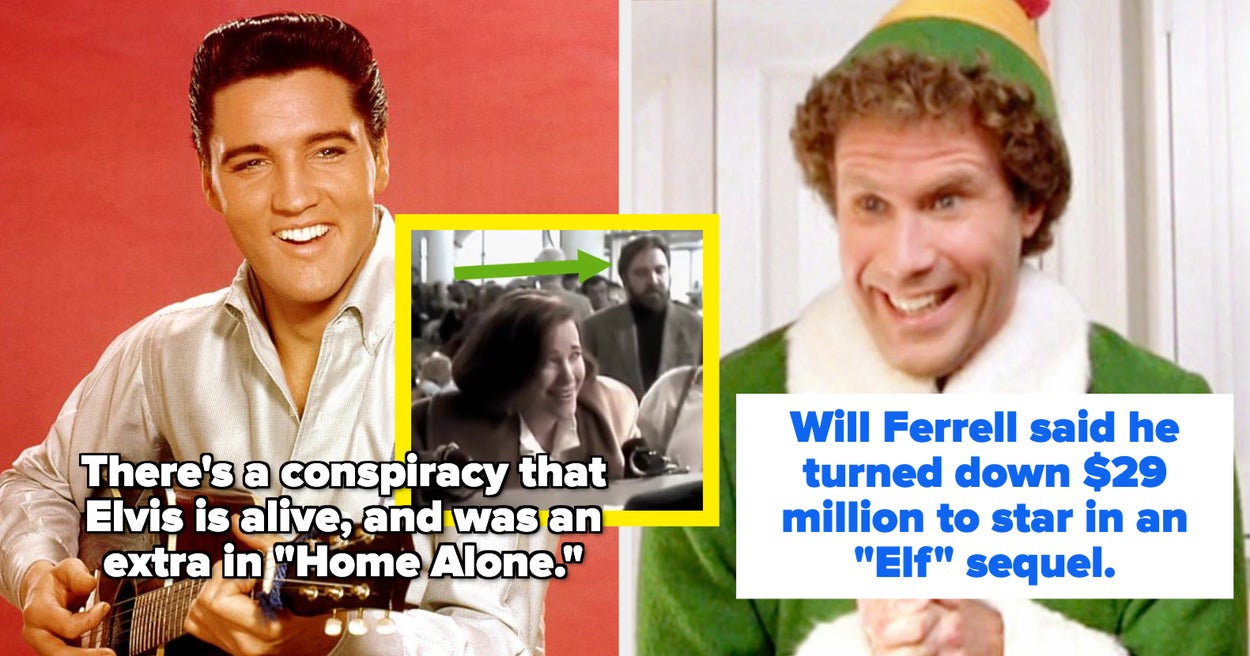1.
Titanic opened in theaters 25 years ago this week. Although the film became one of the most successful movies of all time, it was originally a huge gamble. Previous films about the tragedy hadn’t been very successful, and the only other movie director James Cameron made that was set at sea was 1989’s The Abyss, which ended up being a total flop. To make matters worse, the movie’s budget ended up doubling from its original $110 million cost, making it the most expensive film to ever be made at the time. What’s even wilder is that Titanic‘s alleged $220 million price tag cost even more than it did to build the actual ship! The Titanic cost about $7.5 million to make, which, adjusted to today’s money, is about $200 million.
2.
You’ve probably heard of the many conspiracies that Elvis Presley is still alive, but this one has a very interesting holiday spin! Some believe that Presley, who died in 1977, is not only alive, but can be spotted in a scene of the classic holiday hit Home Alone, which premiered in 1990. Several scenes in the film take place in an airport, as Kate McCallister tries to rush back home to Chicago, where she and her family accidentally left their young son Kevin behind. A few eagle-eyed viewers claim that Elvis can be seen in the background of one of these scenes, waiting in a long line to speak to a customer service representative and notably looking perturbed by the wait.
So, why are people so convinced that this is Elvis? Had Presley not died in 1977, he would have been 55 years old at the time of the movie’s release, which many believe tracks with the man’s appearance. Presley, who was famous for his dark pompadour, actually was a natural blonde, so some who believe this theory have assumed that he quit dyeing his hair at some point. The true kicker is that Elvis was allegedly self-conscious about his long neck, with his ex-wife Priscilla appearing to confirm the insecurity in a 1979 interview. The potential Elvis in the movie is wearing a turtleneck, leading people to wonder if the actor chose to sport that particular style to cover up his neck during his alleged appearance.
Some hardcore believers have even compiled videos comparing the actor’s blink-and-you’ll-miss-it mannerisms to video footage of Presley. This theory has seemingly been debunked by none other than Home Alone director Chris Columbus and child star Macaulay Culkin in a director’s commentary clip. While watching the scene, Columbus brings up the theory to Culkin. “They are convinced, these people, that this is Elvis Presley,” he said. “That he’s faked his death, and because he still loves show business, he’s an extra in Home Alone.” Both Columbus and Culkin shared a big laugh over the theory. “Look at this guy, he’s not Elvis Presley!”
3.
If you were planning to kiss someone under the mistletoe this holiday season, you might wanna rethink that choice! Mistletoe is actually a parasitic plant that attacks and can eventually kill trees by slowly weakening them. According to an ancient Celtic ceremony, mistletoe was used to create an elixir to cure infertility, which historians believe laid the groundwork for the plant to become associated with holiday romance. The plant first appeared in pop culture in 1820 when it was featured in one of Washington Irving’s holiday stories (don’t worry, we’ll learn all about him later!). And as for the name mistletoe? It roughly translates to “bird dung,” which isn’t quite the holly jolly name I was envisioning.
4.
After Princess Diana and King Charles III separated in 1992, Diana allegedly removed Chanel from her fashion rotation because their double-C logo reportedly reminded her of Charles and his girlfriend, Camilla Parker Bowles. In 1996, designer Jayson Brunsdon said he was helping to dress Diana for an appearance and suggested that she wear a pair of shoes featuring the classic Chanel logo. “I found a pair of Chanel shoes, and I said, ‘Well, these would look great with the Versace,’ and she said ‘No, I can’t wear linked Cs, the double C.'” he recalled. “I asked why, and she said, ‘It’s Camilla and Charles.'”
Brunsdon said that he totally understood why Diana would be hesitant to wear the shoes. “The shoes were quite boldly Chanel; I think they had gold linked Cs on them,” he said. “And I think for photo optics, people would have honed in on that considering it was so fresh after the divorce as well.” Just a year before, Diana made her own public comments about Charles and Camilla’s relationship in her famous Panorama interview. “There were three of us in this marriage, so it was a bit crowded,” she revealed.
5.
While you’ve probably learned about the way penguins regurgitate their food into their baby’s mouth, did you know that penguins’ stomachs also act as refrigerators for food for their young? When penguins catch prey, they sometimes swallow it whole and store it inside their stomachs. Once inside the stomach, the food remains at body temperature. Enzymes prevent the penguin from digesting the food until it’s ready to eat.
6.
Jimmy Boyd’s classic song “I Saw Mommy Kissing Santa Claus” was initially condemned by the Catholic Church in Boston when it came out. The song actually was created by Saks Fifth Avenue, after the department store released a postcard featuring a man dressed as Santa Claus kissing a woman while holding a confused child. They commissioned the song to accompany the card, and in 1952, 13-year-old Jimmy Boyd recorded the track, which became a rousing success and quickly reached No. 1.
Despite the song’s evident popularity, not everyone was feeling the love. Upon hearing the song, the Catholic Archdiocese in Boston condemned it because it implied “even a tenuous link between sex and the religious holiday.” The church’s outrage was reportedly so influential that several radio stations even took the song out of their rotations. In order to get the song reinstated, Boyd actually met with a group of priests and reportedly explained that the whole joke of the song was that the Santa in question was actually the child’s father dressed up like Jolly Old Saint Nick, so the mother was not committing adultery. The priests must have accepted Boyd’s explanation, because they supposedly changed their minds about the holiday classic.
View this video on YouTube
Columbia / Via youtube.com
7.
Harry Truman was the first president to celebrate Hanukkah at the White House. On May 8, 1951, Israeli Prime Minister Ben-Gurion presented Truman with a menorah as a birthday gift after Truman officially recognized the State of Israel. The menorah dated back to at least 1767, and was originally located at the Synagogue of Buergel, near Frankfurt-on-Main, Germany. The menorah had been found broken into pieces in 1913, and after being repaired, had been acquired by the Jewish Museum in New York. In 1979, Jimmy Carter held a menorah lighting ceremony, a tradition that every president since has participated in. In 2001, George W. Bush held the first White House Hanukkah party.
8.
When the Gemini 6A launched on December 15, 1965, astronauts Tom Stafford and Wally Schirra decided to celebrate the flight with a rendition of a holiday favorite: “Jingle Bells.” Just before the spacecraft was due to re-enter Earth’s atmosphere, Stafford made an announcement over the radio, saying, “We have an object, looks like a satellite going from north to south, probably in polar orbit….very low, looks like he might be going to re-enter soon….Standby one, you might just let me try to pick up that thing.” Much to the surprise of those on the other end, Stafford began jingling a set of bells he smuggled aboard, while Schirra played the harmonica for a rousing rendition of “Jingle Bells.”
View this video on YouTube
NASA / Via youtube.com
Their performance marked the first musical transmission from space. “Wally came up with the idea,” Stafford recalled in 2005. “He could play the harmonica, and we practiced two or three times before we took off, but of course, we didn’t tell the guys on the ground. We never considered singing, since I couldn’t carry a tune in a bushel basket.” When their instruments were not in use, the astronauts attached them to the walls of the spacecraft using Velcro and dental floss. Both the harmonica and the bells are now on display at the National Air and Space Museum.
9.
Thanks to evolution, reindeer have been able to rather impressively adapt to living in cold temperatures. Their noses are designed to warm air before they breathe it in, ensuring that their mucous membranes remain moist. Their fur also traps air, allowing them to stay warm. Perhaps the most remarkable thing of them all is the way their hooves adapt for the seasons! When the ground is wet and soggy in the summer, their hooves provide extra grip. In the winter, when the ground is icy, the pads on their hooves tighten, giving them extra traction.
10.
Although Washington Irving‘s “The Legend of Sleepy Hollow” helped to define American Halloween culture, his work also shaped the way we celebrate Christmas. Irving’s work notoriously popularized St. Nicholas as a beloved holiday character. According to biographer Andrew Burstein, Irving “did all he could to make minor customs into major customs — to make them enriching signs of family and social togetherness.” Irving’s affection for Old Saint Nick started in one of his short stories in which he wrote, “Good St. Nicholas came riding over the tops of the trees, in that self-same wagon wherein he brings his yearly presents to children,” and alleged that St. Nicholas told the Dutch to settle in Manhattan, effectively creating New York City.
Irving continued to promote St. Nicholas for years. In 1835, he helped found the Saint Nicholas Society of the City of New York, and served as the organization’s secretary until 1841. He frequently wrote about Christmas as a time to exchange gifts and feast with family, all with his St. Nicholas legend at the helm. While some argue that Charles Dickens’s work also helped to popularize the holiday as we know it, historians say that Irving’s holiday essays truly laid the foundation. “Americans embraced Irving’s vision of Christmas as their own, marking the revival of a holiday that had been banned in parts of the country for the excessive drinking and fighting it spurred in the populace.”
11.
Will Ferrell’s Elf performance was so good that he was allegedly offered $29 million to reprise his role as Buddy the Elf in a sequel, which he quickly turned down. “I remember asking myself: could I withstand the criticism when it’s bad and they say, ‘He did the sequel for the money?'” Ferrell told the Guardian. “I decided I wouldn’t be able to. I didn’t want to wander into an area that could erase all the good work I’ve done.”
It also turns out that Ferrell was pretty well prepared to tackle the role of Santa’s sidekick. Before becoming a successful actor, he worked as a mall Santa Claus, with his future Saturday Night Live cast mate, Chris Kattan, working as his elf. On an episode of Jimmy Kimmel Live!, Ferrell joked that he was a “mobile Santa” because he didn’t have a chair or sleigh setup at the open-air mall in Pasadena, California where he worked. Instead, he and Kattan spent four weekends traveling from store to store to spread Christmas cheer. “We’d be like, ‘Hello, J.Crew, ho ho ho,’ ‘Merry Christmas, Sephora, how is everyone doing,’ and they got so sick of us, by the fourth weekend, they’d be like, ‘Hi, Santa,'” he revealed.
12.
Some believe the tradition of leaving cookies and milk for Santa started during the Great Depression as a way for parents to teach their children the importance of giving to others. Cookies were actually brought to America in the late 17th century by the Dutch. As import laws on items like cookie cutters were eliminated, cookies became more popular in the United States as Americans began to put their own spins on classic recipes.
13.
President Herbert Hoover considered himself to be the first student at Stanford. Hoover was reportedly the first student of the school’s first class to sleep in a campus dormitory. While at Stanford, Hoover formed the school’s football team, which he also managed. He helped organize the first “Big Game,” the traditional football game between Stanford and the University of California, Berkley, which is still held today. After graduating from Stanford, Hoover moved to Australia, then China to work in the mining industry.
His time in China ended up paying off once he got to the White House! Hoover and his wife Lou, who both spoke some Mandarin Chinese, would allegedly have entire conversations in the language while in the White House to prevent people from overhearing them, although historians believe Lou had a better grasp on the language than her husband.
14.
While dreidels are now seen as a staple during modern Hanukkah celebrations, they were actually invented as a secret way for Jewish people to engage with their culture. In the 19th century, Greek-Syrians had outlawed Jewish studies. A group of rabbis reportedly developed dreidels, which have the letters Nun, Gimel, Hei, and Pei, which stand for Nes Gadol Haya Poh, or “a Great Miracle Happened Here,” on them to allow Jewish people to continue to engage with the Torah while seemingly just playing a game.
15.
TBH, this one might take the cake for one of the greatest pranks of all time. On April 1, 1996, beloved fast food chain Taco Bell took out full-page ads in seven newspapers announcing that they had purchased the Liberty Bell, which is located in Philadelphia. “In an effort to help the national debt, Taco Bell is pleased to announce that we have agreed to purchase the Liberty Bell, one of our country’s most historic treasures,” the ad read. “It will now be called ‘The Taco Liberty Bell’ and will still be accessible to the American public for viewing. While some may find this controversial, we hope our move will prompt other corporations to take similar action to do their part to reduce the country’s debt.”
Once the news broke, some talk show hosts allegedly believed the stunt, and aired segments questioning the country’s values. Mike McCurry, Bill Clinton’s press secretary, must have thought the joke was hilarious, because he joined in on the fun. “We will be doing a series of these things,” he said. “Ford Motor Company is joining today in an effort to refurbish the Lincoln Memorial. … It will be the Lincoln Mercury Memorial.” Although former National Park Service Director Roger Kennedy made sure he clued the public in on the fact that it was just a joke, park rangers around the country reportedly fielded tons of calls from people who were outraged that the country would sell the bell, and didn’t check to see that it was, in fact, just an April Fool’s stunt. Taco Bell ended up donating $50,000 to efforts to preserve the bell.
16.
This year’s winter solstice will take place on December 21, marking the longest day and shortest night for the Northern hemisphere. Turns out, it tends to be a pretty historical day! The Pilgrims arrived at Plymouth on the solstice in 1620, Pierre and Marie Curie discovered radium on this day in 1898, and the Apollo 8 spacecraft launched during 1968’s solstice.
17.
One of my favorite Christmas traditions is the 24-hour marathon of A Christmas Story, so let’s take a look behind the scenes of the holiday classic, shall we? When it came to casting the movie, director Bob Clark auditioned thousands of child actors to take on the role of Ralphie, but ended up giving the role to Peter Billingsley, who was the very first actor Clark saw during the audition process! Jack Nicholson was in talks to star in the movie as the Old Man, Ralphie’s father, but was allegedly asking for more money than the film’s budget allowed.
Once filming for the flick went underway, production had to jump into action to create the snowy Indiana town the movie takes place in. Although they filmed in Cleveland, Ohio, and Toronto, there was reportedly no snow, so production had to freeze water to create fake snow. It took about 24 hours to create the winter wonderland seen in the film. In one memorable scene, Ralphie is dressed as a cowboy, complete with chewing tobacco in his mouth. While many actors typically used black licorice to mimic the look of chewing tobacco, Billingsley was allegedly given real chewing tobacco instead. Billingsley later revealed that after trying the tobacco, his lips started burning, he got incredibly dizzy, and he started sweating.
But perhaps the most iconic moment of the entire movie was the scene in which a character named Flick is triple-dog-dared to stick his tongue to a frosty pole. The scene was actually filmed by cutting a hole into the pole and putting a suction tube inside. Scott Schwartz, who plays Flick and now runs a child actor advocacy group, said the worst part of filming the scene was not having his tongue stuck to the pole, but the frigid temperatures while filming outside during a Canadian winter. MythBusters actually put the scene to the test and found that in freezing conditions, a tongue actually can get stuck to a metal pole, as saliva turns into “a kind of superglue.”
And as for the movie’s leg lamp? In the movie, the Old Man wins the lamp after entering a contest. The movie was actually based on a book written by Jean Shepherd, who said he was inspired to write about the lamp after seeing a large leg in a Nehi Soda advertisement. Reuben Freed, the movie’s prop designer, said he had no clue what the lamp was supposed to look like, so he presented Shepherd with several potential designs until they landed on the version that made its way into the movie. All three of the lamps Freed made for the film were broken over the course of filming.
18.
While you might assume that the phrase “Bah, humbug” loosely translates to “I hate Christmas,” it’s actually a bit different. Back in the 1700s, “humbug” was seen as a slang word that often represented “nonsense,” “a hoax; a jesting or befooling trick,” or any “thing which is not really what it pretends to be.” It’s believed that the phrase, which was uttered by Scrooge in Charles Dickens’s A Christmas Carol, was actually calling the holiday a scam, with the character believing Christmas tricked people into spending their money and feeling happy and cheerful.
19.
The song “Baby, It’s Cold Outside” has become increasingly controversial over the years, so I decided to deep dive into the song’s history. The song was written in the 1940s by Frank Loesser, who penned the song to sing with his wife at parties, allegedly as an indication that they wanted their guests to leave. The original version of the song labeled the man’s verses as “wolf,” while the sections intended for the woman to sing were labeled “mouse.” Loesser’s wife was reportedly furious when her husband sold the song to MGM in 1948 to be featured in the movie Neptune’s Daughter. The song was widely regarded as a holiday hit until 2004, when two National Post columnists called the song “an ode to statutory rape.”
The column was reportedly written to be tongue-in-cheek to poke fun at political correctness, but some took it seriously. Over the following years, some radio stations pulled the song. A 2010 article from Persephone took a look at the historical context of the song, claiming that lines like “what’s in this drink?” was a common joke at the time. Others have positioned the song as an “anthem for progressive women,” arguing that it advocates for “women’s sexual liberation,” by pushing the boundary that unmarried women weren’t supposed to spend the night at a man’s house.
View this video on YouTube
UMG / Via youtube.com
20.
And finally, Bess Flowers, known as “The Queen of Hollywood Extras,” was one of the most prolific character actors of all time and appeared as an extra in over 350 movies throughout her 40-year career. Flowers, who was originally from Texas, ran away from home and planned to head to New York to escape her overbearing father. She originally wanted to become a Broadway star, but later saw an advertisement for California that inspired her to change course and head to Hollywood instead. In 1922, Flowers got her first role. She was often chosen for parts because of her statuesque height. “[The studios] liked tall women because [leading men] didn’t have to bend down to kiss them and ruin their profile,” she once said.
As “talkies” gained prominence and silent films began to lose popularity, Flowers began to take on bit parts, and also appeared as an extra in dozens of films. Flowers was notorious for buying many of the costumes she wore in films. Whenever agencies were looking for an extra who could provide her own stylish outfit for a scene, they often turned to Flowers. In fact, Flowers had so many clothes that she required a special wardrobe room later in her life when she lived at the Motion Picture Country House in Los Angeles.
Flowers was well-known among notable directors of the time, including Frank Capra and Alfred Hitchcock, who would often request her when looking for extras. Although Flowers rarely received screen credit for her roles, which seldom had any dialogue, she was very recognizable in her work as an extra. As a result of her decades in Hollywood, Flowers has the unique distinction of acting in 23 films that were nominated for Best Picture, making her the actor who has appeared in the most nominated films. In 1945, she helped establish the Screen Extras Guild, which ensured fair pay and working standards for film extras. Flowers made her final film appearance in 1964, and died in 1984.



